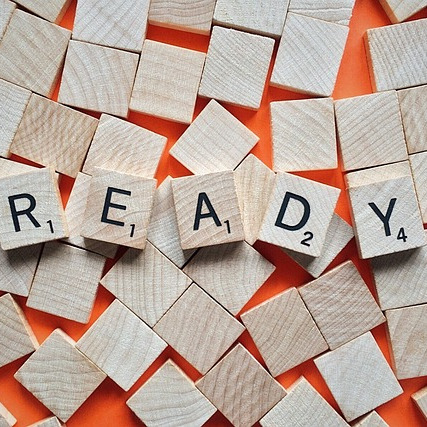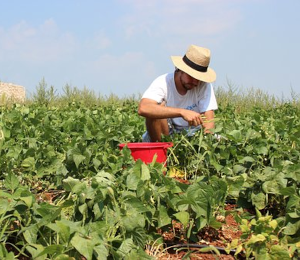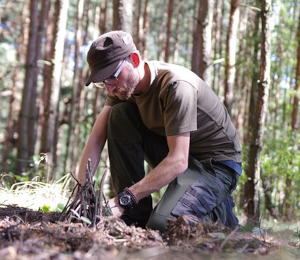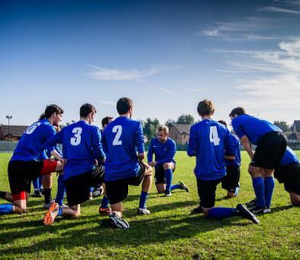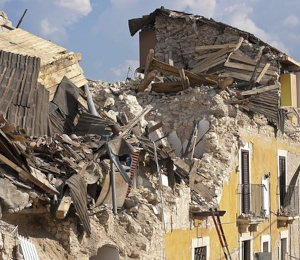
Why talk about earthquakes?
Earthquakes strike suddenly, without warning. Earthquakes can occur at any time of the year and at any time of the day or night. On a yearly basis, 70 to 75 damaging earthquakes occur throughout the world. Estimates of losses from a future earthquake in the United States approach $200 billion.
Forty-five states and territories in the United States are at moderate to very high risk of earthquakes, and they are located in every region of the country. California has experienced the most frequent damaging earthquakes; however, Alaska has experienced the greatest number of large earthquakes—many of which caused little damage because of the area’s low population density at the time.
In November 2002, a magnitude 7.9 earthquake in south-central Alaska ruptured the Denali Fault in the Alaska Mountain Range, about 90 miles (145 kilometers) south of Fairbanks. Although this was the strongest earthquake ever recorded in the interior of Alaska, it caused no deaths and little damage to structures because the region was sparsely populated. In February 2001, the 6.8 magnitude Nisqually earthquake struck the Puget Sound area 12 miles (20 kilometers) northeast of Olympia, Washington. Hundreds of people were injured and damages were estimated at more than $3.5 billion. In January 1994, the Los Angeles region of southern California was struck by a 6.7 magnitude earthquake centered in the San Fernando Valley town of Northridge. The Northridge earthquake killed 57 people, injured 9,000, and displaced 20,000 from their homes. It was one of the costliest earthquakes in U.S. history, destroying or damaging thousands of buildings, collapsing freeway interchanges, and rupturing gas lines that exploded into fires.
The most widely felt sequence of earthquakes in the contiguous 48 states was along the New Madrid Fault in Missouri, where a three-month long series of quakes from 1811 to 1812 included three with estimated magnitudes of 7.6, 7.7, and 7.9 on the Richter Scale. These earthquakes were felt over the entire eastern United States, with Missouri, Tennessee, Kentucky, Indiana, Illinois, Ohio, Alabama, Arkansas, and Mississippi experiencing the strongest ground shaking.
Where earthquakes have occurred in the past, they will happen again.
What are earthquakes and what causes them?
An earthquake is a sudden, rapid shaking of the earth caused by the breaking and shifting of rock beneath the earth’s surface. For hundreds of millions of years, the forces of plate tectonics have shaped the earth as the huge plates that form the surface move slowly over, under, past, and away from each other. Sometimes the movement is gradual. At other times, the plates are locked together, unable to release the accumulating energy as they bend or stretch. When the forces grow strong enough, the plates suddenly break free causing the ground to shake. Most earthquakes occur at the boundaries where two plates meet; however, some earthquakes occur in the middle of plates.
Aftershocks are smaller earthquakes that follow the main shock and can cause further damage to weakened buildings. Aftershocks can occur in the first hours, days, weeks, or even months after the quake. Some earthquakes are actually foreshocks that precede a larger earthquake.
Ground shaking from earthquakes can collapse buildings and bridges; disrupt gas, electric, and telephone service; and sometimes trigger landslides, avalanches, flash floods, fires, and huge, destructive, seismic sea waves called tsunamis. Buildings with foundations resting on unconsolidated landfill and other unstable soils are at increased risk of damage. Also, mobile homes and homes not attached to their foundations are at particular risk because they can be shaken off their foundations during an earthquake. When an earthquake occurs in a populated area, it may cause deaths and injuries and extensive property damage.
The Northridge, California, earthquake of January 17, 1994, struck a modern urban environment generally designed to withstand the forces of earthquakes. Its economic cost, nevertheless, was estimated at $20 billion. Fortunately, relatively few lives were lost. Exactly one year later, Kobe, Japan, a densely populated community less prepared for earthquakes than Northridge, was devastated by one of the most costly earthquakes ever to occur. Property losses were projected at $96 billion, and at least 5,378 people were killed. These two earthquakes tested building codes and construction practices, as well as emergency preparedness and response procedures.
How can I protect myself in an earthquake?
Ground vibrations during an earthquake are seldom the direct cause of death or injury. Most earthquake-related injuries and deaths result from collapsing walls, flying glass, and falling objects caused by the ground shaking. It is extremely important for a person to move as little as possible to reach the place of safety he or she has identified, because most injuries occur when people try to move more than a few feet during the shaking.
Much of the damage caused by earthquakes is predictable and preventable. We must all work together in our communities to apply our knowledge to enact and enforce up-todate building codes, retrofit older unsafe buildings, and avoid building in hazardous areas, such as those prone to landslides. We must also look for and eliminate hazards at home, where our children spend their days, and where we work. And we must learn and practice what to do if an earthquake occurs.
Be Prepared for an Earthquake: Protect Yourself
Core Actions:
- Pick “safe places” in each room.
- Practice drop, cover, and hold on.
For general preparedness, every household should create and practice a Family Disaster Plan and assemble and maintain a Disaster Supplies Kit. In addition, every household should take earthquakespecific precautions and plan and practice what to do in the event of an earthquake.
If you are at risk from earthquakes, you should:
- Discuss with members of your household the possibility of earthquakes and what to do to stay safe if one occurs. Knowing how to respond will help reduce fear.
- Pick “safe places” in each room of your home and your office or school. A safe place could be under a piece of furniture, such as a sturdy table or desk, or against an interior wall away from windows, bookcases, or tall furniture that could fall on you. The shorter the distance to your safe place, the less likely it is that you will be injured by furnishings that become flying debris during the shaking. Injury statistics show that persons moving more than five feet (1.5 meters) during an earthquake’s shaking are the most likely to experience injury.
- Practice drop, cover, and hold on in each safe place. Drop to the floor, take cover under a sturdy piece of furniture, and hold on to a leg of the furniture. If suitable furniture is not nearby, sit on the floor next to an interior wall and cover your head and neck with your arms. Responding quickly in an earthquake may help protect you from injury. Practice drop, cover, and hold on at least twice a year.
- Keep a flashlight and sturdy shoes by each person’s bed.
- Talk with your insurance agent about earthquake protection. Different areas have different requirements for earthquake protection. Study the locations of active faults, and, if you are at risk, consider purchasing earthquake insurance.
- Inform guests, babysitters, and caregivers of earthquake plans. Everyone in your home should know what to do if an earthquake occurs, even if you are not there at the time.
Protect Your Property
Core Actions:
- Secure your home’s structure and objects inside and outside.
If you are at risk from earthquakes, you should:
- Make sure your home is securely anchored to its foundation. Depending on the type of construction and the materials used in building your home, you may need to have it bolted or secured in another way to its foundation. If you are not sure that your home is securely anchored, contact a professional contractor. Homes securely attached to their foundations are less likely to be severely damaged during earthquakes, while homes that are not are frequently ripped from their foundations and become uninhabitable.
- Bolt and brace water heaters and gas appliances to wall studs. If the water heater tips over, the gas line could break, causing a fire hazard, and the water line could rupture. The water heater may be your best source of drinkable water following an earthquake. Consider having a licensed professional install flexible fittings for gas and water pipes.
- Bolt bookcases, china cabinets, and other tall furniture to wall studs. Brace or anchor high or top-heavy objects. During an earthquake, these items can fall over, causing damage or injury.
- Hang heavy items, such as pictures and mirrors, away from beds, couches, and anywhere people sleep or sit. Earthquakes can knock things off walls, causing damage or injury.
- Brace overhead light fixtures. During earthquakes, overhead light fixtures are the most common items to fall, causing damage or injury.
- Install strong latches or bolts on cabinets. The contents of cabinets can shift during the shaking of an earthquake. Latches will prevent cabinets from opening and spilling out the contents. Place large or heavy objects on shelves near the floor.
- Secure large items that might fall and break (televisions, computers, etc.).
- Store weed killers, pesticides, and flammable products securely in closed, latched metal cabinets.
- Evaluate animal facilities and places your pets like to hide in, to ensure that any hazardous substances or structures are dealt with.
- Consider having your building evaluated by a professional structural design engineer. Ask about home repair and strengthening tips for exterior features, such as porches, front and back decks, sliding glass doors, canopies, carports, and garage doors. This is particularly important if there are signs of structural defects, such as foundation cracks. Earthquakes can turn cracks into ruptures and make smaller problems bigger. A professional can give you advice on how to reduce potential damage.
- Follow local seismic building standards and land use codes that regulate land use along fault lines, in areas of steep topography, and along shorelines. Some municipalities, counties, and states have enacted codes and standards to protect property and occupants in case of an earthquake. Learn about your area’s codes before you begin construction.
What to Do During an Earthquake
Core Actions:
- If inside when the shaking starts, move no more than a few steps and drop, cover, and hold on.
- If outside, find a clear spot and drop.
If you are inside when the shaking starts, you should:
- Drop, cover, and hold on. Move only a few steps to a nearby safe place. Most people injured in earthquakes move more than five feet (1.5 meters) during the shaking.
- If you are elderly or have a mobility impairment, remain where you are, bracing yourself in place.
- If you are in bed, stay there, hold on, and protect your head with a pillow. You are less likely to be injured if you stay in bed. Broken glass on the floor can injure you.
- Stay away from windows. Windows can shatter with such force that you can be injured by flying glass even if you are several feet away.
- Stay indoors until the shaking stops and you are sure it is safe to exit. In buildings in the United States, you are safer if you stay where you are until the shaking stops. If you go outside, move quickly away from the building to prevent injury from falling debris.
- Be aware that fire alarm and sprinkler systems frequently go off in buildings during an earthquake, even if there is no fire. Check for and extinguish small fires, and exit via the stairs.
- If you are in a coastal area, drop, cover, and hold on during an earthquake and then move immediately to higher ground when the shaking stops. Tsunamis (large ocean waves) are often generated by earthquakes. (See Tsunami.)
If you are outdoors when the shaking starts, you should:
- Find a clear spot away from buildings, trees, streetlights, and power lines.
- Drop to the ground and stay there until the shaking stops. Injuries can occur from falling trees, streetlights, power lines, and building debris.
- If you are in a vehicle, pull over to a clear location, stop, and stay there with your seatbelt fastened until the shaking stops. Trees, power lines, poles, street signs, overpasses, and other overhead items may fall during earthquakes. Stopping in a clear location will reduce your risk, and a hard-topped vehicle will help protect you from flying or falling objects. Once the shaking has stopped, proceed with caution. Avoid bridges or ramps that might have been damaged by the quake.
- If you are in a mountainous area or near unstable slopes or cliffs, be alert for falling rocks and other debris that could be loosened by the earthquake. Landslides are often triggered by earthquakes. (See Landslide/Debris Flow.)
What to Do After an Earthquake
Core Actions:
- Expect aftershocks.
- Check yourself and then others.
- Look for fires.
When the shaking stops, you should:
- Expect aftershocks. Each time you feel one, drop, cover, and hold on. Aftershocks frequently occur minutes, days, weeks, and even months following an earthquake.
- Check yourself for injuries and get first aid if necessary before helping injured or trapped persons.
- Put on long pants, a long-sleeved shirt, sturdy shoes, and work gloves to protect yourself from injury by broken objects.
- Look quickly for damage in and around your home and get everyone out if your home is unsafe. Aftershocks following earthquakes can cause further damage to unstable buildings. If your home has experienced damage, get out before aftershocks happen. Use the stairs, not an elevator.
- Listen to a portable, battery-operated radio or television for updated emergency information and instructions. If the electricity is out, this may be your main source of information. Local radio and television stations and local officials will provide the most appropriate advice for your particular situation.
- Check the telephones in your home or workplace. If a phone was knocked off its cradle during the shaking of the earthquake, hang it up. Allow 10 seconds or more for the line to reset. If the phone lines are undamaged, you should get a dial tone. Use a telephone or cell phone only to make a brief call to your Family Disaster Plan contact and to report life-threatening emergencies. Telephone lines and cellular equipment are frequently overwhelmed in disaster situations and need to be clear for emergency calls to get through. Cellular telephone equipment is subject to damage by quakes and cell phones may not be able to get a signal, but regular “land line” phones may work.
- Look for and extinguish small fires. Fire is the most common hazard following earthquakes. Fires followed the San Francisco earthquake of 1906 for three days, creating more damage than the earthquake.
- Clean up spilled medications, bleach, gasoline, or other flammable liquids immediately. Avoid the hazard of a chemical emergency.
- Open closet and cabinet doors cautiously. Contents may have shifted during the shaking and could fall, creating further damage or injury.
- Help people who require special assistance—infants, elderly people, those without transportation, large families who may need additional help in an emergency situation, people with disabilities, and the people who care for them.
- Watch out for fallen power lines or broken gas lines, and stay out of damaged areas. Hazards caused by earthquakes are often difficult to see, and you could be easily injured.
- Watch animals closely. Keep all your animals under your direct control. Pets may become disoriented, particularly if the disaster has affected scent markers that normally allow them to find their home. Pets may be able to escape from your house or your fence may be broken. Be aware of hazards at nose and paw level, particularly debris, spilled chemicals, fertilizers, and other substances that might seem to be dangerous to humans. In addition, the behavior of pets maychange dramatically after an earthquake, becoming aggressive or defensive, so be aware of their well-being and take measures to protect them from hazards, including displaced wild animals, and to ensure the safety of other people and animals.
- Stay out of damaged buildings. Damaged buildings may be destroyed by aftershocks following the main quake.
- If you were away from home, return only when authorities say it is safe. When you return home:
- Be alert for and observe official warnings.
- Use extreme caution. Check for damages outside your home. Then, if the structure appears safe to enter, check for damages inside. Building damage may have occurred where you least expect it. Carefully watch every step you take. Get out of the building if you think it is in danger of collapsing. Do not smoke; smoking in confined areas can cause fires.
- Examine walls, floors, doors, staircases, and windows.
- Check for gas leaks. If you smell gas or hear a blowing or hissing noise, open a window and get everyone out quickly. Turn off the gas, using the outside main valve if you can, and call the gas company from a neighbor’s home. If you turn off the gas for any reason, it must be turned back on by a professional.
- Look for damage to the electrical system. If you see sparks or broken or frayed wires, or if you smell burning insulation, turn off the electricity at the main fuse box or circuit breaker. If you have to step in water to get to the fuse box or circuit breaker, call an electrician first for advice.
- Check for damage to sewage and water lines. If you suspect sewage lines are damaged, avoid using the toilets and call a plumber. If water pipes are damaged, contact the water company and avoid using water from the tap. You can obtain safe water from undamaged water heaters or by melting ice cubes. (See Drinking Water Safety.)
- Watch for loose plaster, drywall, and ceilings that could fall. (See Evacuation, Shelter, and Post-Disaster Safety.)
For information on portable-generator safety and carbon monoxide poisoning, see Portable Generators.
Media and Community Education Ideas
- Ask your community to adopt up-to-date building codes. Building codes are the public’s first line of defense against earthquakes. National model building codes are available to communities and states. These codes identify construction techniques for buildings that help them withstand earthquakes without collapsing and killing people. Codes are updated regularly to make use of information learned from recent damaging earthquakes, so adopting and enforcing up-todate codes are essential.
- If your area is at risk from earthquakes, ask your local newspaper or radio or television station to:
- Present information about how to respond if an earthquake occurs.
- Do a series on locating hazards in homes, workplaces, day care centers, schools, etc.
- Provide tips on how to conduct earthquake drills.
- Run interviews with representatives of the gas, electric, and water companies about how individuals should prepare for an earthquake.
- Help the reporters to localize the information by providing them with the local emergency telephone number for the fire, police, and emergency medical services departments (usually 9-1-1) and emergency numbers for the local utilities and hospitals. Also provide the business telephone numbers for the local emergency management office, local American Red Cross chapter, and state geological survey or department of natural resources.
- Work with officials of the local fire, police, and emergency medical services departments; utilities; hospitals; emergency management office; and American Red Cross chapter to prepare and disseminate guidelines for people with mobility impairments about what to do if they have to evacuate.
Facts and Fiction
- Fiction: During an earthquake, you should get into a doorway for protection.
- Fact: In modern homes, doorways are no stronger than any other parts of the structure and usually have doors that will swing and can injure you. During an earthquake, you should get under a sturdy piece of furniture and hold on.
- Fiction: During an earthquake, the earth cracks open and people, cars, and animals can fall into those cracks.
- Fact: The earth does not crack open like the Grand Canyon. The earth moves and rumbles and, during that movement, small cracks can form. The usual displacements of the earth during an earthquake are caused by up-and-down movements, so shifts in the height of the soil are more likely than chasm-like cracks.
- Fiction: Animals can sense earthquakes and give advanced warning.
- Fact: Animals may be able to sense the first low-frequency waves of an earthquake that occurs deep within the earth, but the damage-causing primary and secondary waves follow just seconds behind. Animals do not make good earthquake warning devices.
- Fiction: Big earthquakes always happen in the early morning.
- Fact: Several recent damaging earthquakes have occurred in the early morning, so many people believe that all big earthquakes happen then. In fact, earthquakes occur at all times of day. The 1933 Long Beach earthquake was at 5:54 p.m. and the 1940 Imperial Valley event was at 9:36 p.m. More recently, the 1989 Loma Prieta event was at 5:02 p.m.
- Fiction: It’s hot and dry — earthquake weather!
- Fact: Many people believe that earthquakes are more common in certain kinds of weather. In fact, no correlation with weather has been found. Earthquakes begin many kilometers below the region affected by surface weather. People tend to notice earthquakes that fit the pattern and forget the ones that do not. In all regions of the world, “earthquake weather” is whatever type of weather prevailed at the time of the region’s most memorable earthquake.
- Fiction: Someday there will be beachfront property in Arizona.
- Fact: The ocean is not a great hole into which California can fall, but is itself land at a somewhat lower elevation with water above it. The motion of plates will not make California sink—California is moving horizontally along the San Andreas Fault and up around the Transverse Ranges (coastal California mountains).
- Fiction: We have good building codes so we must have good buildings.
- Fact: The tragedy in Kobe, Japan, one year after the Northridge earthquake, painfully reminds us that the best building codes in the world do nothing for buildings built before that code was enacted. In many earthquake-prone areas of the United States, the building codes are out of date and therefore even new buildings are very vulnerable to severe earthquake damage. Fixing problems in older buildings—retrofitting—is the responsibility of the building’s owner.
- Fiction: Scientists can now predict earthquakes.
- Fact: Scientists do not know how to predict earthquakes, and they do not expect to know how any time in the foreseeable future. However, based on scientific data, probabilities can be calculated for potential future earthquakes. For example, scientists estimate that during the next 30 years the probability of a major earthquake occurring is 67 percent in the San Francisco Bay area and 60 percent in southern California.
Learn More
Learn if earthquakes are a risk in your area by contacting your local emergency management office, local American Red Cross chapter, or state geological survey or department of natural resources. Information about earthquake risk is also available from the Web site of the U.S. Geological Survey National Seismic Hazards Project: http://eqhazmaps.usgs.gov/.
Read More
